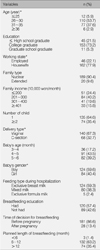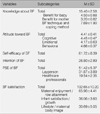Abstract
Purpose
This study was done to investigate the level of breastfeeding satisfaction, the relationship among knowledge about breastfeeding, attitude toward breastfeeding, self-efficacy of breastfeeding, intention of breastfeeding, and perceived social encouragement of breastfeeding and the factors influencing breastfeeding satisfaction in mothers 3~6 months after birth.
Methods
For this descriptive research, 209 mothers who had been breastfeeding their babies agreed to participate in this study. Data on mother's satisfaction, knowledge, attitude, self-efficacy, intention, and perceived social encouragement regarding breastfeeding were collected by closed-ended questionnaires on September 14, 2007 at a contest for healthy breast-fed babies.
Results
The major findings of this study were as follows: First, there were significant differences in the breastfeeding satisfaction level according to planned length of breastfeeding (F=10.43, p<.001). Second, there was a significant relationship between breastfeeding satisfaction and knowledge about breastfeeding (r=.37, p<.001), attitude toward breastfeeding (r=.62, p<.001), self-efficacy of breastfeeding (r=.66, p<.001), intention of breastfeeding (r=.40, p<.001), and perceived social encouragement of breastfeeding (r=.32, p<.001). Finally, the strongest factor affecting mothers' breastfeeding satisfaction was attitude toward breastfeeding (β=.38). Other factors included self-efficacy of breastfeeding (β=.36), knowledge about breastfeeding (β=.14), perceived social encouragement of breastfeeding (β=.10), and planned length of breastfeeding (β=.10).
Figures and Tables
References
1. Bandura A. Self-efficacy in changing societies. 2008. Cambridge: Cambridge University Press.
2. Cattaneo A., Quintero-Romero S. Protection, promotion, and support of breastfeeding in low-income countries. Semin Fetal Neonatal Med. 2006. 11(1):48–53.

3. Cernades J.M., Noceda G., Barrera L., Martinez A.M., Garsd A. Maternal and perinatal factors influencing the duration of exclusive breastfeeding during the first 6 months of life. J Hum Lact. 2003. 19(2):136–144.

4. Cooke M., Sheehan A., Schmied V. A description of the relationship between breastfeeding experiences, breastfeeding satisfaction, and weaning in the first 3 months after birth. J Hum Lact. 2003. 19(2):145–156.

5. Dennis C.L. Breastfeeding initiation and duration: A 1990-2000 literature review. J Obstet Gynecol Neonatal Nurs. 2002. 31(1):12–32.

6. Dennis C.L. The breastfeeding self-efficacy scale: Psychometric assessment of the short form. J Obstet Gynecol Neonatal Nurs. 2003. 32(6):734–744.

7. Dennis C.L., Faux S. Development and psychometric testing of the breastfeeding self-efficacy scale. Res Nurs Health. 1999. 22(5):399–409.

8. Ertem I.O., Votto N., Leventhal J.M. The timing and predictors of the early termination of breastfeeding. Pediatrics. 2001. 107(3):543–548.

9. Hannula L., Kaunonen M., Tarkka M.T. A systematic review of professional support interventions for breastfeeding. J Clin Nurs. 2008. 17(9):1132–1143.

10. Huggins K., Ziedrich L. The nursing mother's guide to weaning. 2007. Boston, MA: The Harvard Common Press.
11. Jang G.J., Kim S.H., Jeong K.S. Effect of postpartum breast-feeding support by nurse on the breast-feeding prevalence. J Korean Acad Nurs. 2008. 38(1):172–179.

12. Janke J.R. Development of the breast-feeding attrition prediction tool. Nurs Res. 1994. 43(2):100–104.

13. Jeong G.H. Effect of the nursing intervention program on promoting the breastfeeding practice in primipara. 1997. Seoul: Ewha Womans University;Unpublished doctoral dissertation.
14. Kim H.S., Nam E.S. Prediction of breastfeeding intentions and behaviors: An application of the theory of planned behavior. J Korean Acad Nurs. 1997. 27(4):796–806.
15. Kim S.G., Cho A.J., Kim Y.K., Do S.R., Lee G.W. The survey on the national fertility, family health and welfare in Korea. 2006. Seoul: Korea Institute for Health and Social Affairs.
16. Kim S.J., Yang S.J. A study of primiparous women's breastfeeding experience. J Korean Acad Nurs. 1997. 27(3):477–488.

17. Kronborg H., Vaeth M. The influence of psychosocial factors on the duration of breastfeeding. Scand J Public Health. 2004. 32(3):210–216.

18. Lee S.O. A study about breastfeeding knowledge, attitude, and problem of breastfeeding in early postpartum period and breastfeeding practice. Korean J Women Health Nurs. 2003. 9(2):179–188.

19. Lee S.O., Chung E.S., Ahn S.H., Moon G.N., Park N.H. A study of predictors of breastfeeding. Korean J Child Health Nurs. 2003. 9(4):368–375.
20. Lee E.J. The effect of prenatal breastfeeding education on breastfeeding practice and retention of knowledge. 1997. Daegu: Keimyung University;Unpublished master's thesis.
21. Leff E.W., Gagne M.P., Jefferis S.C. Maternal perceptions of successful breastfeeding. J Hum Lac. 1994. 10(2):99–104.

22. Leff E.W., Jeffereis S.C., Gagne M.P. The development of the maternal breastfeeding evaluation scale. J Hum Lac. 1994. 10(2):105–111.

23. 2005 Korean national health and nutrition survey: Nutrition survey. Ministry of Health and Welfare. 2006. 07. Retrieved October 12, 2007. from http://www.mw.go.kr/front/al/sal0301ls.jsp?PAR_MENU_ID=04&MENU_ID=0403.
24. Rempel L.A. Factors influencing the breastfeeding decisions of long-term breastfeeders. J Hum Lac. 2004. 20(3):306–318.

25. Riordan J.M. Breastfeeding and human lactation. 2005. 3rd ed. Sudbury MA: Jones and Bartlett Publishers.
26. Scott J.A., Binns C.W., Oddy W.H., Graham K.I. Predictors of breastfeeding duration: Evidence from a cohort study. Pediatrics. 2006. 117(4):e646–e655.

27. Semenic S., Loiselle C., Gottlieb L. Predictors of the duration of exclusive breastfeeding among first-time mothers. Res Nurs Health. 2008. 31(5):428–441.

28. Swanson V., Power K.G. Initiation and continuation of breastfeeding: Theory of planned behaviour. J Adv Nurs. 2005. 50(3):272–282.

29. Yeo J.H. Influencing factors in breast feeding duration. Korean J Women Health Nurs. 2005. 11(2):142–147.

30. Yoon J.W. The development and evaluation of the breastfeeding self-efficacy program for working mothers. 2005. Seoul: Korea University;Unpublished doctoral dissertation.
31. Yun S.E. Effect of the breastfeeding knowledge, method, and feeding rate in primipara about the education of breastfeeding according to the stage of the prenatal and postnatal period. 2003. Gongju: Kongju National University;Unpublished master's thesis.




 PDF
PDF ePub
ePub Citation
Citation Print
Print







 XML Download
XML Download